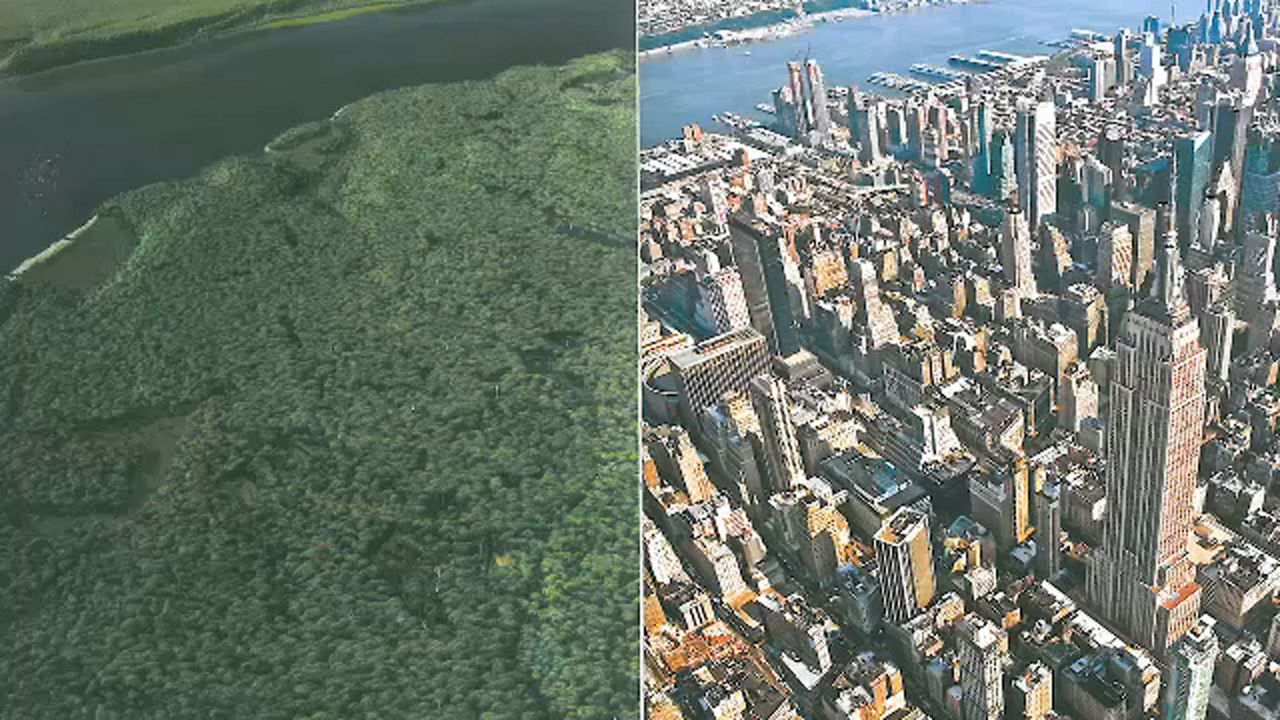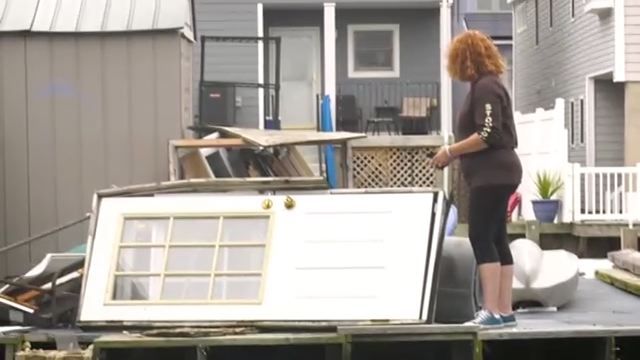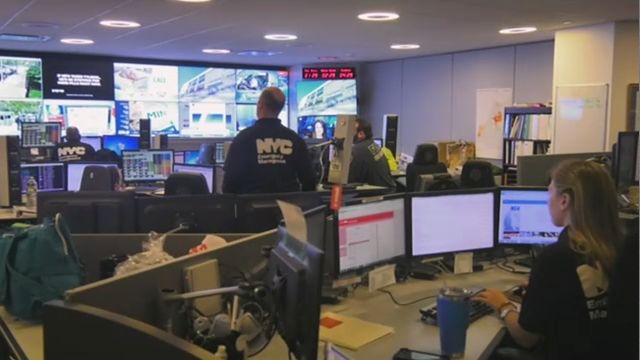They were meant to protect tens of thousands — or even hundreds of thousands — of New Yorkers from flooding — and they were supposed to be in place by last year. But some major projects are scaled back and far behind schedule. And it's not only city projects falling short. NY1's Josh Robin reports in Part Three of his series, Sandy: Five Years Later.
At the Brooklyn Navy Yard, where World War II ships were made, Mayor Michael Bloomberg announced a new assault.
"This is urgent work, and it must begin now," Bloomberg said in June of 2013.
Mere months after Hurricane Sandy, the enemy was clear: a changing planet.
His battle plan was a more than 400-page-long blueprint to fortify New York against rising temperatures and rising seas.
Coastal protection was crucial, and City Hall underscored its importance with an ambitious deadline: By 2016 "flood protection systems" were to be in place at five spots in the Bronx, Manhattan, and Brooklyn.
Tens of millions of dollars per location, they would block or divert water surge, whether with moveable panels or something more permanent.
Five years after the storm, the protections don't exist. They lack funding. They're only in plans that are a fraction of what was first demanded.
From the South Bronx to Lower Manhattan to the Brooklyn waterfront, it's unclear when drawings in an official book will turn into shovels in the ground.
"I believe that they were achievable," Seth Pinsky, who oversaw Bloomberg's resiliency plan. "I believe that they were the right timeframes to choose, because the threat can come at any moment."
It's not just the city's plans that have fallen short. At a cost of almost $44 million, after Sandy the federal government pumped 4 million cubic yards of sand to replenish beaches on Coney Island and the Rockaways.
But in the Rockaways, they've yet to put in kinds of structures, seen in the video above, which would help keep the sand from washing back.
That's left several gap-toothed sections of the beach.
"The ocean is our back yard, so we see it every day, so we're completely and keenly aware just how — just what a force it is," said Kevin Boyle, the publisher of the Rockaway Times. "People in other parts of the city may forget."
Let's start in Lower Manhattan. A series of walls once called the Big U has been downsized to three sections.
The city is making the most progress in turning a park into more than a playground. As envisioned, rolling hills would intercept the East River from deluging nearby apartment buildings.
The boundaries were a bit different, but here's the original goal: A completion date of 2016.
In December 2014, was the deadline pushed back three years, with construction to go until 2019.
Fast-forward to this summer — completion was pushed back to 2024.
Water gushed into other parts of Manhattan, but two other sections south and west have fewer funds and there are no construction dates yet.
Let's move to the Hunts Point Food Market, where as much as 60 percent of our fruits and vegetables are brought into the city.
The Bloomberg report called for at least $150 million in protection, which was to be completed by 2016.
City Hall now is spending $45 million, launching a project for backup electricity that's on track for 2022.
For East Harlem, the report warned of a "risk for flooding during extreme weather events." The goal there was up to $200 million, with an expected completion of 2016. A progress report shows work on a study would begin this year.
Red Hook was supposed to have up to $200 million for flood protection completed by last year. The city now has half that amount for a flood protection system. The federal government is reviewing the project, clouding when it will be in place.
There are some measures that can help in the meantime. Barriers, seen in the video above, can block flooding that is a problem in Red Hook.
But that's only if the water doesn't come as high as it did during Sandy. The barriers are four feet tall; five years ago, the water reached six feet high.
One bright spot is the Rockaway Boardwalk, which was rebuilt far stronger after Sandy.
That's where we met Dan Zarrilli, Mayor Bill de Blasio's Chief Resiliency Officer. He wrote the section on coastal resiliency in the Bloomberg Administration.
"The deadlines that were, of course, set out in that report in 2013 were set out six months after the storm. Some cases, they were aspirational; in some cases, they were very aggressive, and that's great," Zarrilli said. "We need to continue to push to get these projects in place as quick as possible, and we've been moving projects and hitting milestones to get them done."
City projects are often complex, and funding from Washington often comes reluctantly, to put it charitably.
Zarrilli said the program is evolving, with the same goal of adapting the city.
"They're complicated — no one is going to dispute that," Zarrilli said. "At the same time, we are continuing to push on and pull on every lever that we need in order to get these projects done."
"Every day that goes by is a day that we're not protected, and that's concerning," Pinsky said.
Pinsky, who oversaw the Bloomberg report, says the de Blasio administration is moving aggressively on environmental resiliency.
He also notes this administration's environmental plan is about more than the environment.
In April 2015, de Blasio announced a follow up to Bloomberg's book: 350 pages of goals.
Familiar flood projects are there, and there's even a picture of his predecessor.
But it also sets goals for diversity in government, criminal justice reform, and reducing poverty.
"You can't have environmental sustainability without economic sustainability, nor can you have economic sustainability without environmental sustainability," de Blasio said.
Pinsky says that while de Blasio's objectives are "very, very important," he added that "there are issues that are existential in nature.
"I would argue that climate change is one of a very, very small handful of issues that are truly existential when it comes to the future of New York City."
"The focus on equity while we're delivering climate action is absolutely essential to make sure that we're building a city that works for all New Yorkers," Zarrilli said.
Bloomberg, through a spokesman, declined to comment. His plans required $4.5 billion from sources he didn't specify.
Strategies to cover the gap are listed, but search "subject to available funding" and it comes up more than a hundred times.
One project where there isn't a gap in funding is a $600 million, 5.5-mile seawall between Fort Wadsworth and Oakwood Beach on Staten Island. Construction starts in 2019, and completion is expected by the end of 2023.
The Army Corps of Engineers is considering something even bigger: A storm surge barrier. In the video above, you can see one in the Netherlands.
As envisioned between Sandy Hook, New Jersey, and Breezy Point, Queens, it would cost billions of dollars and take years to construct.
As it considers that barrier, the Corps recommends a smaller one on Jamaica Bay, from the Rockaways to Manhattan Beach, Brooklyn.
"I think we're moving as fast as we can," said Anthony Ciorra of the Army Corps of Engineers. "But of course the risk is that there will always be another storm that could come in beforehand — and that's why we still maintain a sense of urgency."
But critics have said that the Corps isn't moving as fast as it can on the Rockaways.
After dredging, the beach was the widest it has been since the 1990s. That was before sections of sand washed away in natural erosion.
That won't be a problem at an oceanfront beach not too far away in Nassau County, Long Island. In Long Beach, the Army Corps of Engineers is building structures to prevent erosion.
City officials have said they want the same thing in Queens. The Corps counters that the Long Beach project was authorized back in 1996.
It's another sign of the distance between what's proposed, and what's done.
There is money for Queens, but the project still needs sign-offs from several federal layers. The earliest construction would start is 2020.








